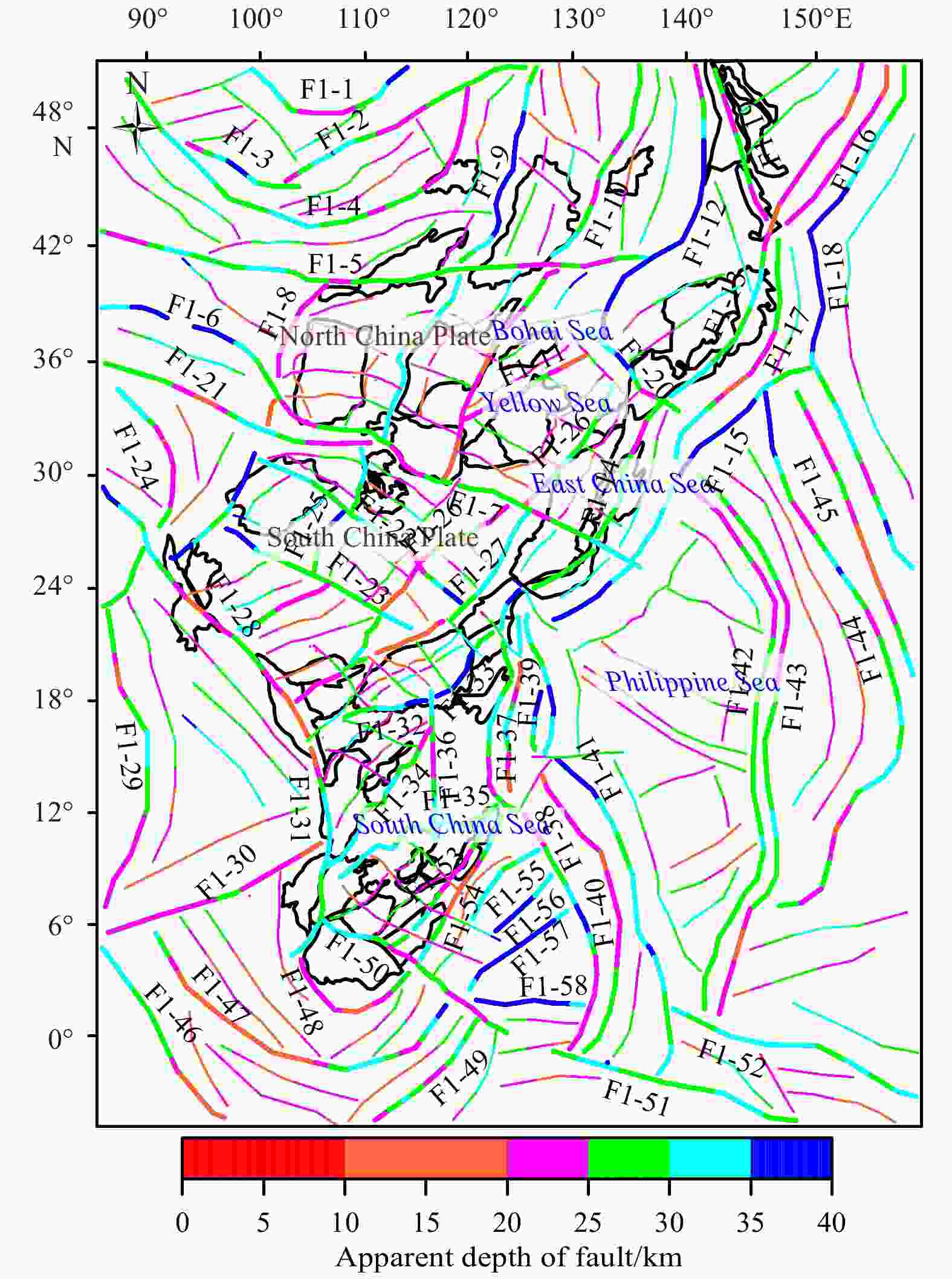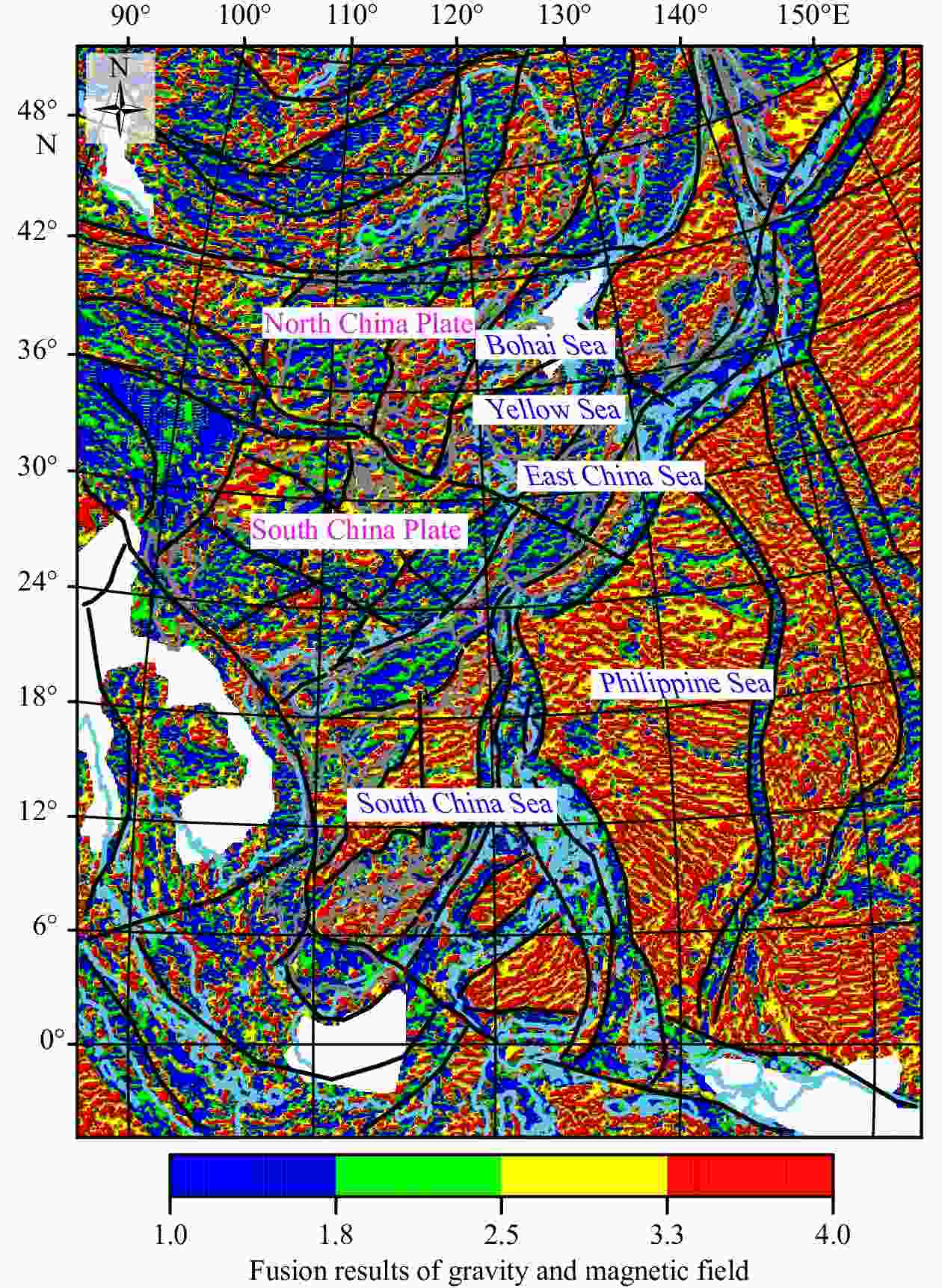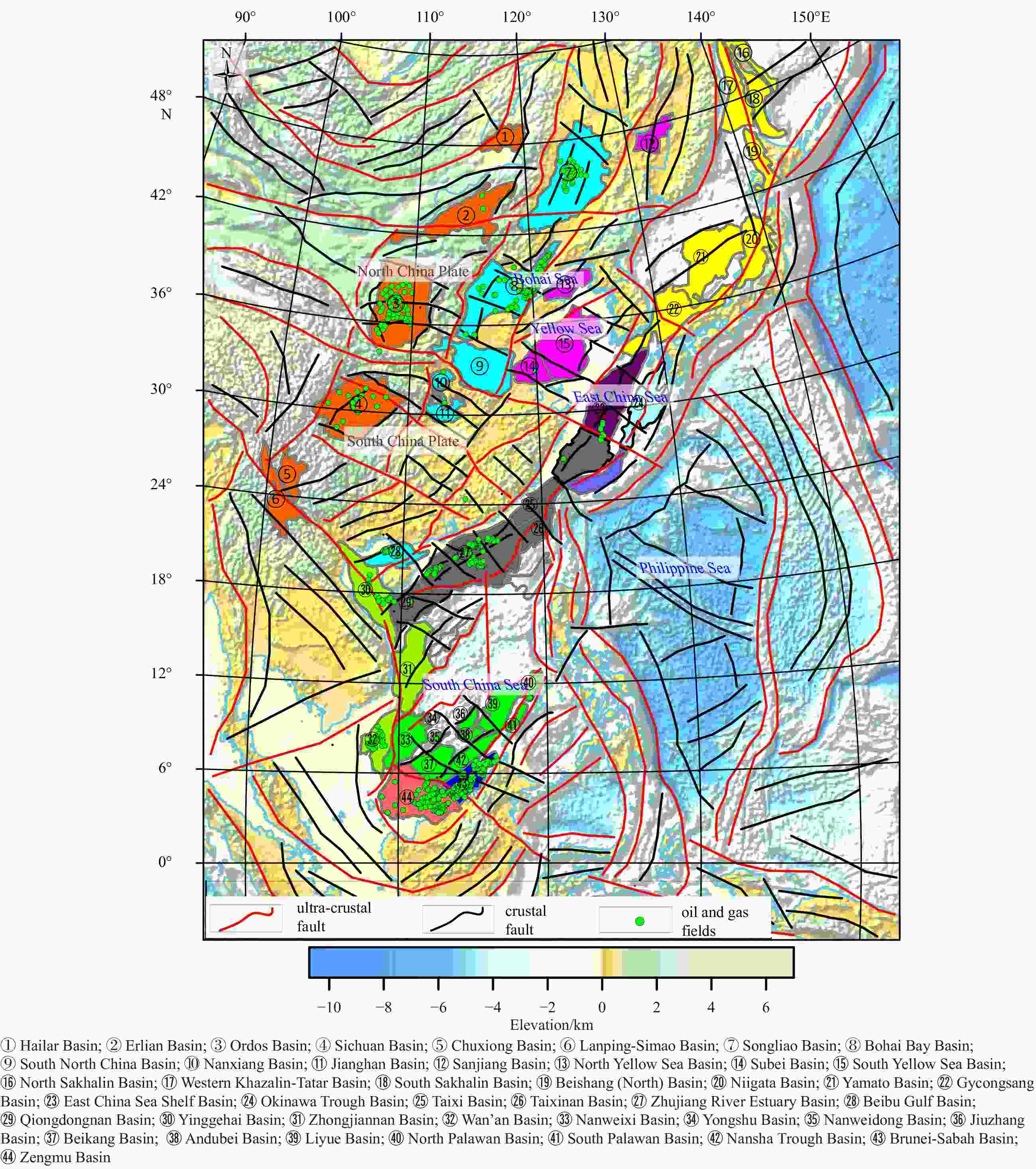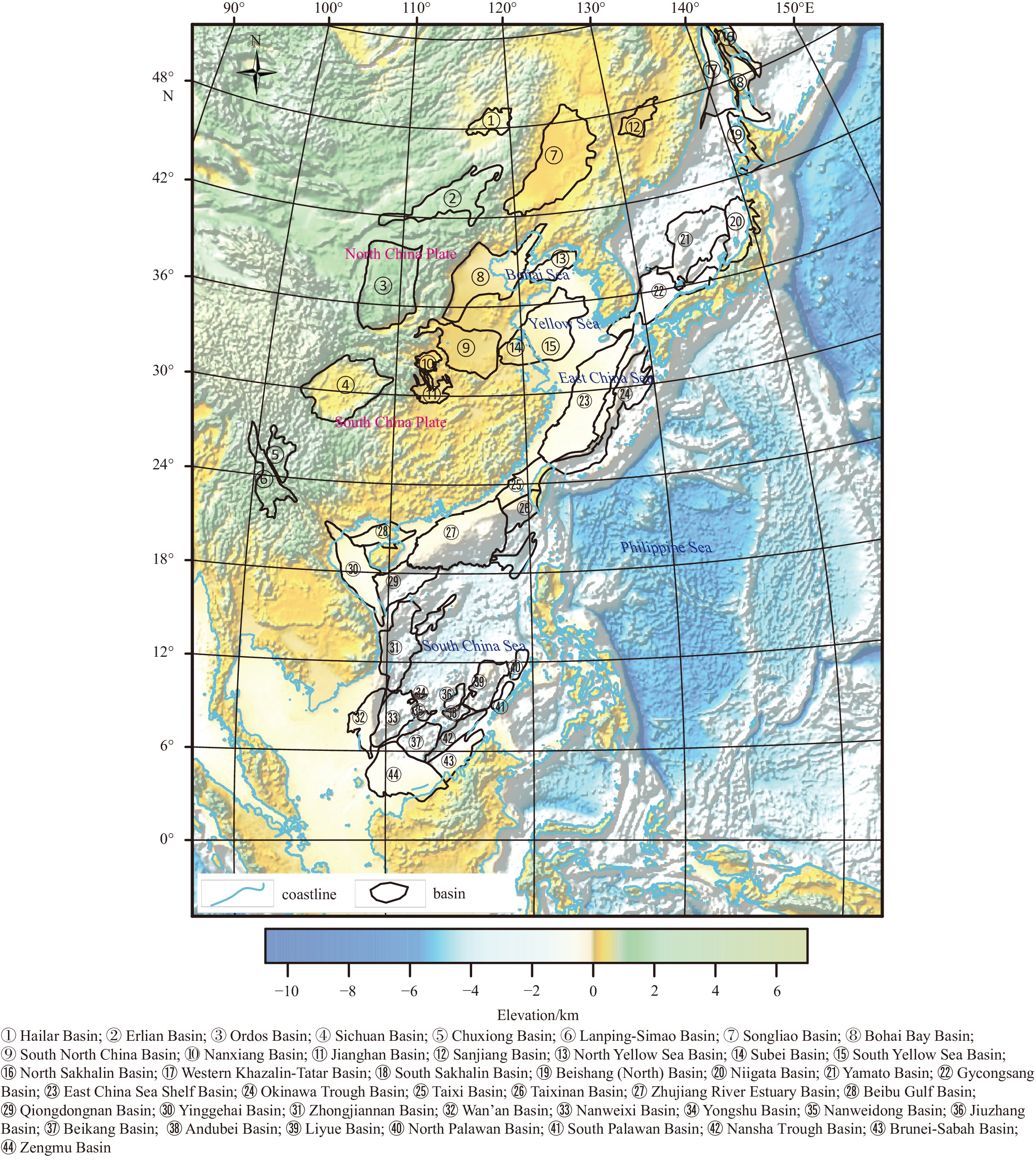Study on the distribution characteristics of faults and their control over petroliferous basins in the China seas and its adjacent areas
-
Abstract: As one of the main controlling factors of oil and gas accumulation, faults are closely related to the distribution of oil and gas reservoirs. Studying how faults control petroliferous basins is particularly important. In this work, we investigated the plane positions of major faults in the China seas and its adjacent areas using the normalized vertical derivative of the total horizontal derivative (NVDR-THDR) of the Bouguer gravity anomaly, the fusion results of gravity and magnetic anomalies, and the residual Bouguer gravity anomaly. The apparent depths of major faults in the China seas and its adjacent areas were inverted using the Tilt-Euler method based on the Bouguer gravity anomaly. The results show that the strikes of the faults in the China seas and its adjacent areas are mainly NE and NW, followed by EW, and near-SN. Among them, the lengths of most ultra-crustal faults are in the range of 1 000–3 000 km, and their apparent depths lie between 10 km and 40 km. The lengths of crustal faults lie between 300 km and 1 000 km, and their apparent depths are between 0 km and 20 km. According to the plane positions and apparent depths of the faults, we put forward the concept of fault influence factor for the first time. Based on this factor, the key areas for oil and gas exploration were found as follows: the east of South North China Basin in the intracontinental rift basins; the southeast region of East China Sea Shelf Basin, the Taixinan and Qiongdongnan basins in the continental margin rift basins; Zhongjiannan Basin in the strike-slip pull-apart basins; the Liyue, Beikang, and the Nanweixi basins in the rifted continental basins. This work provides valuable insights into oil and gas exploration, mineral resource exploration, and deep geological structure research in the China seas and its adjacent areas.
-
Figure 1. Basin distribution in the China seas and its adjacent areas (according to Zhang et al., 2010, 2016).
Figure 3. Brief map of the tectonic location of China seas and its adjacent areas (Li et al., 2018 ).
Table 1. Statistical table of ultra-crust fault attributes in China seas and its adjacent areas
Fracture
numberName Strike Location Properties (Tian and Luo, 2019; Yang et al., 2021) Length/
kmApparent
depth/kmSegment number of fracture F1-1 northern margin fault of the Tuwa-Mongolia block NW–EW–NE northwest compression 1167 20–35 1 F1-2 eastern margin fault of the Tuwa-Mongolia block NEE northwest compression 1664 20–30 1 F1-3 western margin fault of the Tuwa-Mongolia block NWW northwest compression 782 20–35 1 F1-4 Altai-Erguna fault NW–EW–NE northwest compression 2986 20–35 1 F1-5 northern margin fault of North China Block EW northwest compression 3475 20–35 1 F1-6 Dabie-Qinling orogenic fault NWW northwest compression 2604 25–40 1 F1-7 Yushanjiumi fault NWW center strike slip 1273 20–30 1 F1-8 Helan-Longmenshan fault NNE west compression 2040 20–40 3 F1-9 Daxing’ anling-Taihangshan fault NNE northwest strike slip 2652 30–40 2 F1-10 Tan-Lu fault NEE north strike slip 2925 10–35 3 F1-11 Sulu orogenic fault NEE center compression 851 10–25 1 F1-12 west margin fault of the Japan Sea NNE northeast subduction 1960 30–40 1 F1-13 east margin fault of the Japan Sea NNE northeast subduction 2490 20–35 1 F1-14 western margin fault of the Okinawa Trough NE east subduction 1494 25–35 2 F1-15 eastern margin fault of the Okinawa Trough NE east subduction 2360 30–40 2 F1-16 east margin fault of Chiba Islands NE northeast subduction 1211 20–25 1 F1-17 east margin fault of Japan Island NEE–NNE northeast subduction 1631 20–30 1 F1-18 Pacific subduction fault SN northeast subduction 3502 25–40 1 F1-19 Hokkaido-Hasarin fault NNW northeast subduction 969 20–30 1 F1-20 south margin fault of the Japan Sea NW northeast strike slip 779 25–35 1 F1-21 fault of Southern Dabie Qinling orogenic belt NWW west compression 1763 25–35 1 F1-22 north Yangtze block fault NW center compression 1581 20–35 1 F1-23 south Yangtze block fault NW center compression 1324 25–40 1 F1-24 Kongkala-Lancang River combined fault SN west compression 1023 20–30 1 F1-25 Wuyishan fault NNE center compression 1561 20–35 3 F1-26 Jiangshao fault NE center compression 2453 20–30 4 F1-27 coastal fault in the northern South China Sea NEE–NE center tension 1925 10–35 4 F1-28 Red River fault NW west strike slip 2071 10–30 1 F1-29 western margin fault of Indochina block SN west strike slip 2413 20–30 2 F1-30 Mekong fault NEE southwest strike slip 1475 20–25 1 F1-31 west margin fault of South China Sea SN west strike slip 1403 25–35 1 F1-32 Xisha Trough fault EW center tension 537 25–35 1 F1-33 Mesozoic subduction fault NE center subduction 556 30–40 2 F1-34 northern boundary of the oceanic crust in the South China Sea NE central south tension 1155 25–35 1 F1-35 southern boundary of the oceanic crust in the South China Sea NE central south tension 1189 25–35 2 F1-36 Zhongnan-Liyue fault SN center strike slip 929 20–35 1 F1-37 Manila Trench fault SN east subduction 1530 25–35 3 F1-38 western margin fault of the Philippine subduction zone SN southeast subduction 1614 20–30 1 F1-39 secondary fault of Manila Trench SN center subduction 1099 20–35 2 F1-40 secondary fault of Philippine Trench SN southeast subduction 2430 20–30 1 F1-41 eastern margin fault of the Philippine subduction zone SN southeast subduction 3203 25–40 2 F1-42 western margin fault of Palau Ridge in Kyushu SN southeast tension 3596 20–30 1 F1-43 eastern margin fault of Palau Ridge in Kyushu SN southeast tension 3678 20–30 1 F1-44 Mariana Trench fault SN east subduction 3741 20–30 1 F1-45 Izu-Bonin subduction fault NNW east subduction 1914 10–25 1 F1-46 Sumatra fault NW southwest compression 1308 20–35 1 F1-47 Malacca Strait fault NW–EW–NE southwest strike slip 2330 10–30 1 F1-48 Lupal fault NW southwest strike slip 952 20–25 1 F1-49 Makassar Strait fault NE south strike slip 922 20–35 1 F1-50 Tingjia fault NW south strike slip 1397 20–35 1 F1-51 southern fault of New Guinea NWW southeast subduction 1604 25–35 1 F1-52 New Guinea subduction fault NWW southeast subduction 1666 25–35 1 F1-53 southern margin fault of the Nansha Trough NE south strike slip 997 20–35 4 F1-54 Saba-Palawan fault NE south compression 1050 10–30 4 F1-55 northern Sulu Sea fault NE south tension 618 25–35 1 F1-56 southern Sulu Sea fault NE south tension 500 30–40 1 F1-57 northern Sulawesi Sea fault NEE south tension 794 30–40 1 F1-58 southern Sulawesi Sea fault EW south tension 697 30–40 1 Table 2. Basin types in the China seas and its adjacent areas (Chen et al., 2019)
Type of basin Name of basin Intracontinental rift basin Hailar Basin, Erlian Basin, Ordos Basin, Sichuan Basin, Chuxiong Basin and Lanping-Simao Basin, Songliao Basin, Bohai Bay Basin, South North China Basin, Nanxiang Basin, Jianghan Basin, Sanjiang Basin, North Yellow Sea Basin, Subei Basin, South Yellow Sea Basin, Beibu Gulf Basin Continental margin rift basin East China Sea Shelf Basin, Taixi Basin, Taixinan Basin, Pearl River Estuary Basin, Qiongdongnan Basin Strike-slip pull-apart basin Chuxiong Basin, Lanping-Simao Basin, Yinggehai Basin, Zhongjiannan Basin, Wan’an Basin Rifted continental basin Beikang Basin, Liyue Basin, Nanweixi Basin, Nabweidong Basin, Yongshu Basin, Jiuzhang Basin, Andubei Basin, North Palawan Basin, South Palawan Basin Back-arc basin Okinawa Trough Basin Fore-arc basin Brunei-Sabah Basin Foreland basin Zengmu Basin Table 3. The new basin types and main controlled faults in China sea and adjacent areas
Type of basin Name of basin Faults controlling the basins Previous study This study Intracontinental rift basin First region Hailaer Basin, Erlian Basin, Ordos Basin and Sichuan Basin, Chuxiong Basin and Lanping-Simao Basin, northern margin fault of the North China Block, Dabie-Qinling orogenic fault, Helan-Longmenshan fault, Daxing’an ling-Taihangshan fault, Wuyishan fault Second region Songliao Basin, Bohai Bay Basin, South North China Basin, Nanxiang Basin, Jianghan Basin and Beibu Gulf Basin northern margin fault of the North China Block, Dabie-Qinling orogenic fault, Daxing’anling-Taihangshan fault, Wuyishan fault, Tan-Lu fault Third region Sanjiang Basin, North Yellow Sea Basin, Subei Basin and South Yellow Sea Basin he northern margin fault of the North China Block, Yushanjiumi fault, Tan-Lu fault, Sulu orogenic fault Continental margin rift basin First region north part of the East China Sea Shelf Basin Jiangshao fault, Yushanjiumi fault Second region south part of the East China Sea Shelf Basin, Taixi Basin, Taixinan Basin, Zhujiang River Estuary Basin, Qiongdongnan Basin Yushanjiumi fault, The coastal fault in the northern South China Sea, Mesozoic subduction fault, Xisha Trough fault Strike-slip pull-apart basin Yinggehai Basin, Zhongjiannan Basin, Wan’an Basin Red River fault, West margin fault of South China Sea Rifted continental basin Beikang Basin, Liyue Basin, Nanweixi Basin, Nanweidong Basin, Yongshu Basin, Jiuzhang Basin, Andubei Basin, North Palawan Basin, South Palawan Basin southern boundary of the oceanic crust in the South China Sea, the southern margin fault of the Nansha Trough, western margin fault of the South China Sea, the Tingjia fault Back-arc basin First region north part of Okinawa Trough Basin Yushanjiumi fault, western margin fault of Okinawa trough, eastern margin fault of Okinawa trough Second region south part of Okinawa Trough Basin Yushanjiumi fault, western margin fault of Okinawa trough, eastern margin fault of Okinawa trough Fore-arc basin Brunei-Sabah Basin southern margin fault of Nansha Trough, Sabah-Palawan fault Foreland basin Zengmu Basin Lupal fault, Tingjia fault -
An Huiting, Li Sanzhong, Suo Yanhui, et al. 2012. Basin-controlling faults and formation mechanism of the Cenozoic basin groups in the western South China Sea. Marine Geology and Quaternary Geology (in Chinese), 32(6): 95–111 An Yulin, Zhang Minghua, Huang Jinming, et al. 2010. The computation scheme and computation process for gravity correction values within the pure spherical coordinate system. Geophysical & Geochemical Exploration (in Chinese), 34(6): 697–705 Chen Jianwen, Liang Jie, Zhang Yinguo, et al. 2019. Regional evaluation of oil and gas resources in offshore China and exploration of marine Paleo-Mesozoic oil and gas in the Yellow Sea and East China Sea. Marine Geology & Quaternary Geology (in Chinese), 39(6): 1–29 Chen Hanzong, Wu Xiangjie, Zhou Di, et al. 2005. Meso-Cenozoic faults in Zhujiang River Mouth Basin and their geodynamic background. Journal of Tropical Oceanography (in Chinese), 24(2): 52–61 Cunningham W D, Mann P. 2007. Tectonics of strike-slip restraining and releasing bends. Geological Society, London, Special Publications, 290(1): 1–12 Dai Weiming, Huang Danian, Li Tonglin, et al. 2018. The edge detection method and its application in the south China Sea based on the gravity gradient structure tensor eigenvalue. Chinese Journal of Geophysics (in Chinese), 61(6): 2494–2507 Feng Xuliang, Zhang Gongcheng, Wang Wanyin, et al. 2018. An integrated study on distribution of Cenozoic basins in the South China Sea based on gravity, magnetic and seismic data. Chinese Journal of Geophysics (in Chinese), 61(10): 4242–4254 Hall R. 2002. Cenozoic geological and plate tectonic evolution of SE Asia and the SW Pacific: computer-based reconstructions, model and animations. Journal of Asian Earth Sciences, 20(4): 353–431. doi: 10.1016/S1367-9120(01)00069-4 Harding T P. 1973. Newport-Inglewood trend, California—An example of wrenching style of deformation. AAPG Bulletin, 57(1): 97–116 He Tao, Wang Wanyin, Huang Jinming, et al. 2019. The research of the regularization method in the ratio methods of edge recognition by potential field. Geophysical and Geochemical Exploration (in Chinese), 43(2): 308–319 He Tao, Xiong Shengqing, Wang Wanyin. 2022. Three-dimensional transformation of magnetization direction and magnetic field component at low latitudes based on vertical relationship. Applied Geophysics, 19(1): 91–106. doi: 10.1007/s11770-022-0928-4 Ji Xiaolin, Wang Wanyin, Qiu Zhiyun. 2015. The research to the minimum curvature technique for potential field data separation. Chinese Journal of Geophysics (in Chinese), 58(3): 1042–1058 Laske G, Masters G, Ma Z T, et al. 2013. Update on Crust1.0-A 1-degree global model of Earth’s crust. EGU General Assembly Conference Abstracts, 15: 2658 Lees J M. 2002. Three-dimensional anatomy of a geothermal field. In: Glazner A, Walker J D, Bartley J M, eds. Geologic Evolution of the Central Mojave Desert and Southern Basin and Range. Memoir of the Geological Society of America, 195: 259–276 Lei Shoumin. 1984. Calculation of generalized topographic and isostatic gravity corrections. Marine Geology & Quaternary Geology (in Chinese), (1): 101–111 Li Jiabiao. 2008. Regional Geology of the East China Sea (in Chinese). Beijing: China Ocean Press Li Sanzhong, Cao Xianzhi, Wang Guangzeng, et al. 2019. Meso-Cenozoic tectonic evolution and plate reconstruction of the Pacific Plate. Journal of Geomechanics (in Chinese), 25(5): 642–677 Li Jiabiao, Ding Weiwei, Wu Ziyin, et al. 2017. Origin of the East China Sea. Scientia Sinica Terrae (in Chinese), 47(4): 406–411. doi: 10.1360/N072017-00006 Li Sanzhong, Suo Yanhui, Li Xiyao, et al. 2018. Mesozoic plate subduction in west Pacific and tectono-magmatic response in the East Asian ocean-continent connection zone. Chinese Science Bulletin (in Chinese), 63(16): 1550–1593 Lin Changsong, Gao Yinyao, Zhao Lihong, et al. 2009. Geophysical features of the western-edge fault zone of the South China Sea and its significance of tectonic geology. Acta Oceanologica Sinica (in Chinese), 31(2): 97–103 Liu Guangding. 1992. Geological and Geophysical Characteristics of China’s Sea and Adjacent Areas (in Chinese). Beijing: Science Press Liu Yixuan. 1986. Discussion on the basic characteristics and activity of the Nan’ao Fault Zone and the Coastal Fault Zone. South China Journal of Seismology (in Chinese), 6(3): 1–8 Liu Shaofei. 2018. Study on the distribution of basins, faults and igneous rocks by gravity and magnetic in the South China Sea (in Chinese)[dissertation]. Beijing: China University of Geosciences Lu Baoliang, Ma Tao, Xiong Shengqing, et al. 2020. A new recognition method for source locations and attributes based on correlation analysis of gravity and magnetic anomalies. Chinese Journal of Geophysics (in Chinese), 63(4): 1663–1674 Lu Baoliang, Wang Pujun, Zhang Gongcheng, et al. 2015. Characteristic of regional fractures in South China Sea and its basement tectonic framework. Progress in Geophysics (in Chinese), 30(4): 1544–1553 Luo Xin’gang, Wang Wanyin, Zhang Gongcheng, et al. 2018. Study on distribution features of faults based on gravity data in the South China Sea and its adjacent areas. Chinese Journal of Geophysics (in Chinese), 61(10): 4255–4268 Lv Dingyou. 2012. Study of relationship between Cenozoic structure movement and hydrocarbon accumulation on Tanlu strike-slip fault zone in Bohai sea (in Chinese)[dissertation]. Beijing: China University of Geosciences Makino M, Mandanas A A, Catane S G. 2007. Gravity basement of the Guinsaugon landslide along the Philippine Fault Zone. Earth, Planets and Space, 59(10): 1067–1071 Martel S J. 1990. Formation of compound strike-slip fault zones, Mount Abbot quadrangle, California. Journal of Structural Geology, 12(7): 869–882. doi: 10.1016/0191-8141(90)90060-C Qin Xuwen, Shi Xianyao, Zhang Yong, et al. 2020. Main achievements and understanding of 1:1 million regional geological survey of China Seas. Geology in China (in Chinese), 47(5): 1355–1369 Salem A, Williams S, Fairhead D, et al. 2008. Interpretation of magnetic data using tilt-angle derivatives. Geophysics, 73(1): L1–L10. doi: 10.1190/1.2799992 Sandwell D T, Harper H, Tozer B, et al. 2021. Gravity field recovery from geodetic altimeter missions. Advances in Space Research, 68(2): 1059–1072. doi: 10.1016/j.asr.2019.09.011 Sandwell D T, Müller R D, Smith W H F, et al. 2014. New global marine gravity model from CryoSat-2 and Jason-1 reveals buried tectonic structure. Science, 346(6205): 65–67. doi: 10.1126/science.1258213 Song Haibin, Hao Tianyao, Jiang Weiwei, et al. 2002. Researches on geophysical field characteristics and basement fault system of South China Sea. Progress in Geophysics (in Chinese), 17(1): 24–34 Stewart J H, Poole F G. 1975. Extension of the cordilleran miogeosynclinal belt to the San Andreas Fault, Southern California. Geological Society of America Bulletin, 86(2): 205–212. doi: 10.1130/0016-7606(1975)86<205:EOTCMB>2.0.CO;2 Tian Jianhui, Luo Yan. 2019. Characteristics of stress field in Mainland China and surrounding areas. Earthquake (in Chinese), 39(2): 110–121 Tsutsumi H, Perez J S. 2013. Large-scale active fault map of the Philippine fault based on aerial photograph interpretation. Active Fault Research, 2013(39): 29–37 Wang Jiahao, Chen Honghan, Wang Hua, et al. 2011. Two types of strike-slip and transtensional intrabasinal structures controlling sandbodies in Yitong Graben. Journal of Earth Science, 22(3): 316–325. doi: 10.1007/s12583-011-0184-7 Wang Wanyin, Pan Yu, Qiu Zhiyun. 2009. A new edge recognition technology based on the normalized vertical derivative of the total horizontal derivative for potential field data. Applied Geophysics, 6(3): 226–233. doi: 10.1007/s11770-009-0026-x Wu Shiguo, Fan Jianke, Dong Dongdong. 2013. Discussion on the tectonic division of the Philippine Sea Plate. Chinese Journal of Geology (in Chinese), 48(3): 677–692 Wu Decheng, Zhu Xiaoqing, Wang Qingliang, et al. 2020. Characteristics of active faults related to deep faults in the northwestern part of the South Yellow Sea. Marine Geology Frontiers (in Chinese), 36(2): 12–18 Xie Yuhong, Gao Yangdong. 2020. Recent domestic exploration progress and direction of CNOOC. China Petroleum Exploration (in Chinese), 25(1): 20–30 Xu Huilong, Ye Chunming, Qiu Xuelin, et al. 2010. Studies on the Binhai fault zone in the northern South China Sea by the deep geophysical exploration and its seismogenic structure. South China Journal of Seismology (in Chinese), 30(Suppl): 10–18 Yang Gaoxue, Li Yongjun, Si Guohao, et al. 2021. Discussion on time and mechanism of subduction initiation in the Western Central Asian orogenic belt. Journal of Earth Sciences and Environment (in Chinese), 43(2): 244–261 Zhai Mingguo, Zhu Rixiang, Liu Jianming, et al. 2004. Time range of Mesozoic tectonic regime inversion in eastern North China Block. Science in China Series D: Earth Sciences, 47(2): 151–159. doi: 10.1360/02yd0416 Zhang Xunhua. 2008. Tectonic Geology in China’ Seas (in Chinese). Beijing: China Ocean Press Zhang Gongcheng, Jia Qingjun, Wang Wanyin, et al. 2018. On tectonic framework and evolution of the South China Sea. Chinese Journal of Geophysics (in Chinese), 61(10): 4194–4215 Zhang Yimi, Wang Wanyin, Li Linzhi, et al. 2023. Influence of the Moho surface distribution on the oil and gas basins in China seas and adjacent areas. Acta Oceanologica Sinica, 42(3): 167–188. doi: 10.1007/s13131-022-2136-8 Zhang Yong, Yao Yongjian, Li Xuejie, et al. 2020. Tectonic evolution and resource-environmental effect of China Seas and adjacent areas under the multisphere geodynamic system of the East Asia ocean-continent convergent belt since Mesozoic. Geology in China (in Chinese), 47(5): 1271–1309 Zhang Gongcheng, Zhang Houhe, Zhao Zhao, et al. 2016. “Joint control of source rocks and geothermal heat”—oil enrichment pattern of China’s offshore basins. China Petroleum Exploration (in Chinese), 21(4): 38–53 Zhang Gongcheng, Zhu Weilin, Mi Lijun, et al. 2010. The theory of hydrocarbon genernation controlled by source rock and heat from circle distribution of outside-oil fields and inside-gas fields in South China Sea. Acta Sedimentologica Sinica (in Chinese), 28(5): 987–1005 Zheng Han, Sun Xiaomeng, Wang Pujun, et al. 2019. Mesozoic tectonic evolution of the Proto-South China Sea: A perspective from radiolarian paleobiogeography. Journal of Asian Earth Sciences, 179: 37–55. doi: 10.1016/j.jseaes.2019.04.009 Zhu Xiuxiang, Lü Xiuxiang, Wang Deying, et al. 2009a. Controlling effect of a strike-slip transform belt on hydrocarbon accumulations in the Huanghekou Sag, the Bohai Sea waters. Oil & Gas Geology (in Chinese), 30(4): 476–482 Zhu Weilin, Mi Lijun, Gong Zaisheng, et al. 2009b. Oil and Gas Accumulation and Exploration in the Bohai Sea (in Chinese). Beijing: Science Press Zhu Yingjie, Wang Wanyin, Farquharson C G, et al. 2021. Normalized vertical derivatives in the edge enhancement of maximum-edge-recognition methods in potential fields. Geophysics, 86(4): G23–G34. doi: 10.1190/geo2020-0165.1 Zhu Guang, Wang Yongsheng, Niu Manlan, et al. 2004. Synorogenic movement of the Tan-Lu fault zone. Earth Science Frontier (in Chinese), 11(3): 169–182 -




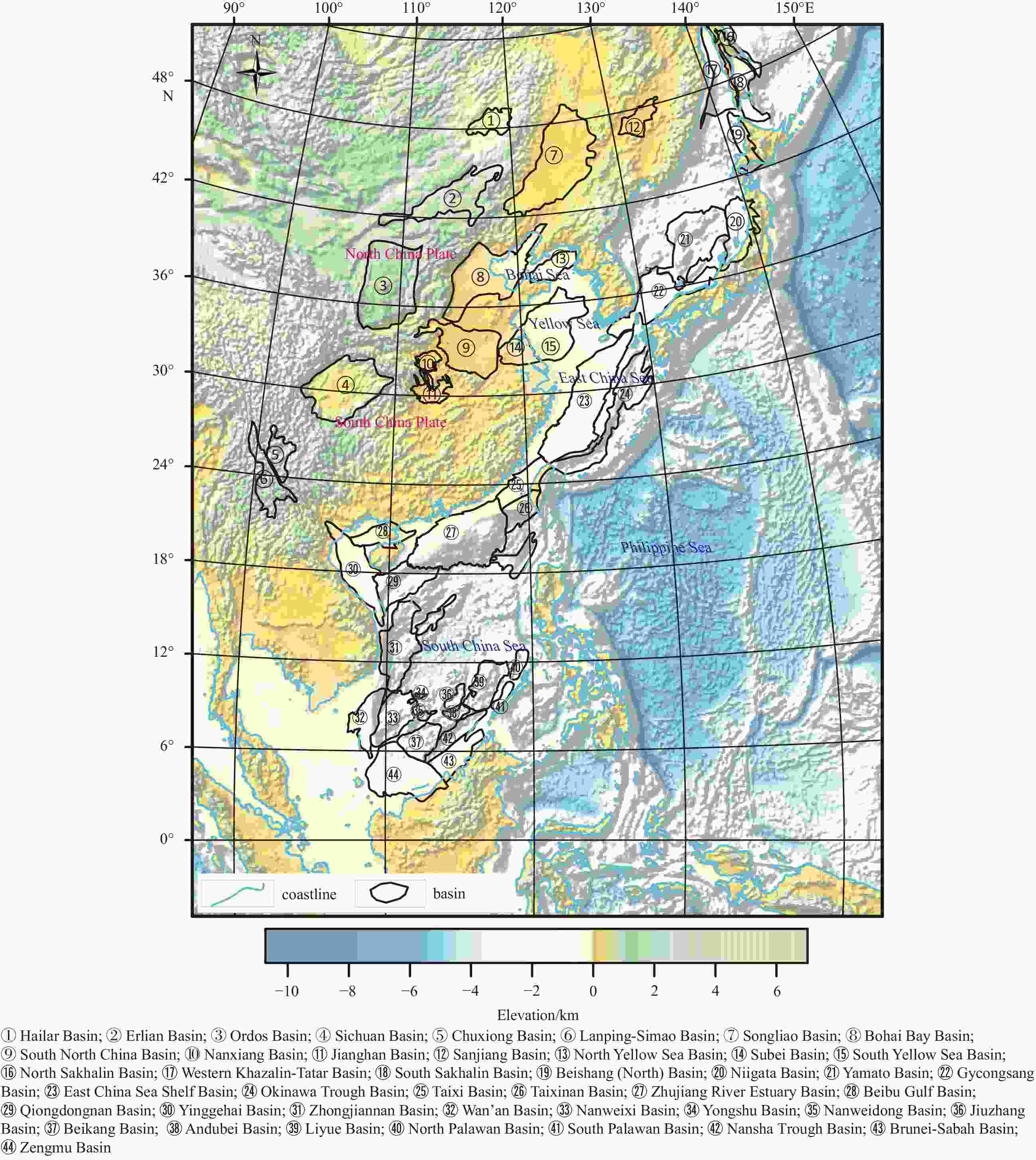
 下载:
下载:




